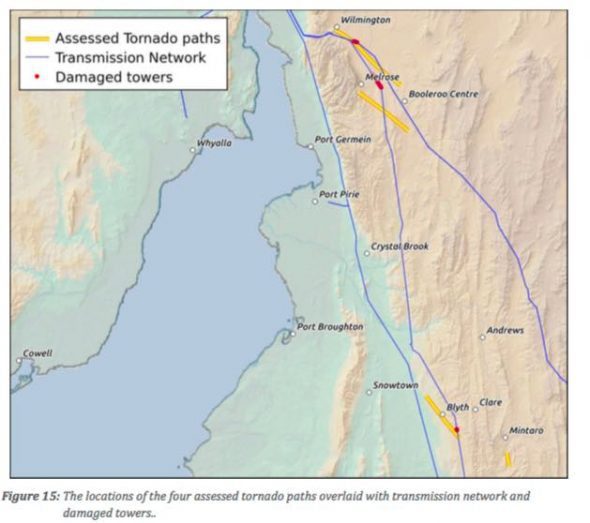
The Bureau of Meteorology says wind gusts up to 260km/h from a “supercell” thunderstorm and multiple tornadoes were recorded on September 28, destroying transmission towers and causing the state-wide blackout in South Australia.
The report from the BoM – which mapped the passage of storm and 7 tornadoes over critical network infrastructure – makes it clear that a freak weather event was responsible for the grid blackout, but it also raises questions about the actions of the Australian Energy Market Operator.
AEMO has attempted to shift the blame to wind energy for the blackout, but has conceded that it took no action to protect energy security as the storms rolled across the state.
In its report, BoM says it issued clear warnings of “destructive winds” as well as heavy rainfall and large hailstones three times before the blackout, the first at 12.26pm in South Australia, the second at 2.10pm, and the third at 3.26pm. The blackout occurred at 3.38pm.

Indeed, it had forecast a severe weather event two days earlier, given the extraordinary conditions that were developing. “Escalating confidence in the historical significance of the approaching weather system on Monday 26 September provided the SES a firm platform for pre-emptive activation strategies,” the BoM writes.
But AEMO did nothing and continued to run the interconnector at near full capacity and called for no contingency back-up.
South Australia energy minister Tom Koutsantonis says the report “should put to rest the debate” over who or what was to blame for the blackout.
“Prime Minister Malcolm Turnbull and Deputy Prime Minister Barnaby Joyce have both used the blackout to attack renewable energy policies in other states,” he said.
“And as recently as just a few weeks ago Steven Marshall claimed in parliament that storms did not caused the blackout, and accused the Premier of misleading parliament when he suggested they did.
“This report clearly and definitively states that tornadoes destroyed transmission lines in the north of South Australia, triggering the blackout. It’s time opponents of renewable energy accept that fact.”
 South Australia has proposed rule change requests to the Australian Energy Market Commission which seek to give AEMO greater power to manage system security in the National Electricity Market.
South Australia has proposed rule change requests to the Australian Energy Market Commission which seek to give AEMO greater power to manage system security in the National Electricity Market.
But many in the market argue that the rules are already sufficient for AEMO to act.
“The rules under Chapter 4 (of the NEM rules) give AEMO all the power that they need –AEMO have narrowed their interpretation of the existing rules and proceduralised themselves into a corner to the extent that they have forgotten what they should do in certain circumstances,” said one wind farm operator on the condition of anonymity.
He and other experts note that AEMO often declares a “credible” contingency when lightning strikes are observed, yet it did nothing when the supercell, thousands of lighting strikes and destructive winds tore across the state on September 28.
They are outraged by the actions of the AEMO, particularly its attempts to blame wind energy, and calling for an independent inquiry into AEMO’s actions, or lack of them, on that day and subsequently.
“It should be done by an international expert – for two reasons: the local experts are reluctant to take the problem on as they derive much of their income doing work for AEMO and AEMO has made problems for engineers in the past.
“Secondly we need to have experts in wind modelling and network modelling take a fresh look at the performance of the grid. AEMO have prepared a slick set of slides – basically because the wind tripped off therefore the power swing occurred therefore wind is to blame … and then what they are doing to fix it.
“But it does not question any of the actions that they took (or did not take). In fact it goes to great lengths to take a simplistic view of how SA Generators and Electranet are meant to inform AEMO of issues so that AEMO can do their job.”
AEMO said it would not respond immediately to the BoM report, but would include its findings in its next report on the blackout due in the middle of December.
According to the BoM, the winds peaked at 260km/h – around the same as Cyclone Tracy the destroyed Darwin and nearly as high as Cyclone Yasi. This comes as the Climate Council predicted more major storms in coming years thanks to climate change.
It has found evidence that confirms that the one tornado cut a direct path across the Davenport-Belalie/Davenport-Mt Lock transmission lines – destroying five transmission towers.
The report also found that another tornado was in the vicinity of the Brinkworth – Templars West transmission line at the time two transmission towers were destroyed.
The Devenport – Brinkworth transmission line was brought down by sustained, severe winds from the supercell thunderstorm. The BOM report confirms at least seven tornadoes impacted the area, as well as severe wind gusts and very large hailstones.
All told, 22 towers across the network and three of the four transmission lines moving power between Adelaide and the north of South Australia were damaged. The subsequent cascading event resulted in a system black for South Australia at 3:48pm local time.










